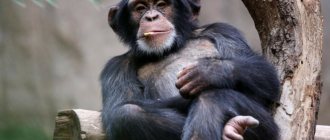The genus of the family of hominids of the primate order called chimpanzees includes two species: the common chimpanzee (Pan troglodytes) and the dwarf chimpanzee (Pan paniscus), or bonobo. They are endangered and are found in the western and central regions of the African continent. The average height of adult males reaches 150 cm, females - 130 cm. Chimpanzees live mainly in groups, which consist of 10-12 individuals. Adult chimpanzees leave their group and create a new one. Primates spend the night high in the trees.
Scientific classification
- Kingdom: Animalia (animals)
- Phylum: Chordata
- Class: Mammalia (mammals)
- Order: Primates (primates)
- Family: Hominidae (hominids)
- Genus: Pan (chimpanzee)
- Species: Pan troglodytes (common chimpanzee)
The chimpanzee genus is divided into two main species:
- the common chimpanzee (Pan troglodytes), which is found on the west coast of Central Africa;
- pygmy chimpanzee, or bonobo, (Pan Paniscus), living in the forests of the Democratic Republic of the Congo (southern region of the Congo Basin).
The Congo River represents the boundary between the habitats of these two species.
Photo: BioOne
The common chimpanzee, in turn, has four subspecies :
- East African or long-haired chimpanzee (Pan troglodytes schweinfurthii);
- Central African or black-faced chimpanzee (Pan troglodytes troglodytes);
- Nigerian chimpanzee (Pan troglodytes vellerosus);
- Western chimpanzee (Pan troglodytes verus).
Origin
Some argue that chimpanzees should be placed in the same genus as humans, Homo, based on the fact that chimpanzees and humans diverged only 4–6 million years ago . The consequences of changing taxonomic classification could have a huge impact on the perception of chimpanzees and the rights extended to them. For example, categorizing chimpanzees as "Homo" may make it unethical to keep them in zoos or use them in research.
Photo: Pinterest
Every few years or months, we are surprised to hear about the differences and similarities between the chromosomes and DNA design of humans and primates. Over the past decade, studies have shown similarities of 98.8%, 95%, 96%, 86-89%, and a recent study by Jeffrey P. Tomkins (Institute for Creation Research, Texas, USA) suggests it is as low as 70%.
As more innovative research methods emerge, further reports and numbers may become more accurate. Today, scientists have not yet come to a consensus to what extent the DNA of chimpanzees and humans may be similar.
6) Food
Humans and chimpanzees are omnivorous creatures, so we eat both plants and meat. However, humans are more carnivorous than chimpanzees, and our digestive systems are designed to digest enough meat. Chimpanzees sometimes kill and eat other animals, often monkeys of other species, but much more often prefer fruit and sometimes eat insects. People are much more dependent on meat because the vitamin B12 we need can only be obtained from meat products.
Based on studies of the digestive systems and lifestyles of some ancient tribes, scientists believe that people adapted to eat meat at least once every few days. Humans prefer to eat at specific times and do not spend the entire day eating, another characteristic of carnivores. This is due to the nutritional properties of the product, as well as the fact that to obtain it you need to go hunting.
Character traits
Appearance
All chimpanzees are black or dark brown, but they are born with light-colored faces that darken with age. The primate's body is covered with long, coarse hair; it does not grow only on the muzzle, the inside of the arms and the soles of the feet. In juveniles these parts of the body are pink and become graphite/black over time. Males and females have white beards .
Chimpanzees, like other monkeys, also do not have a tail. They have protruding ears and very long arms. The total length of both limbs is approximately 1.5 times the length of the entire body. The upper limbs are longer than the lower ones.
Anatomical features
The human brain is approximately three times the size of a chimpanzee's . The volume of the human brain is 1200-1400 cm³, and the chimpanzee brain is from 282 to 500 cm³.
Compared to gorillas, chimpanzees have huge testicles. The first testicle weighs about 110 grams, and a gorilla's weighs 28 grams. For comparison, the weight of a human testicle does not exceed 43 grams. The large size of chimpanzee testicles is determined by its sexual behavior during mating. Males try to impregnate as many females as possible, so they must have a large number of sperm so that rivals are less likely to leave offspring.
Intelligence
Photo: Reader's Digest
It has been noted that chimpanzees can create tools and use them to obtain food. They have complex hunting strategies that require cooperation and the ability to influence other individuals. These primates are capable of deception and manipulation . They can learn to use symbols and understand the basics of human language. To some extent, they can also make plans.
Chimpanzees also build above-ground nests by tying together the branches of one or more trees. This is an important skill, especially for females who build nests, especially juveniles. They are installed on trees with a trunk diameter of at least 5 meters. Nests are built at a height of 3 to 45 meters above ground level. Construction takes place both during the day and at night.
Emotions and feelings
Chimpanzees generally cooperate, especially when patrolling, searching for food, etc. Chimpanzees have been shown to be motivated by altruism . A primate from one community is indifferent to harm caused to an individual from another group. Females and males sometimes hug orphaned cubs from other packs, but most often kill them.
Chimpanzees have their own, broadly understood spirituality. They grieve, fall in love, quarrel. Primates can also perform the so-called "rain dance" . They admire the beauty of the world around them, such as sunsets; are interested in other animals and treat them with respect. Scientists have often observed chimpanzees' altruism towards smaller animals such as turtles. They sometimes give inanimate objects (such as rocks) the characteristics of an animate creature by hugging and caressing them.
Dimensions
Chimpanzees have very few morphological differences between subspecies. They have a more robust build than bonobos and little sexual dimorphism : males weigh between 35 and 70 kg and females between 25 and 50 kg. Representatives of both sexes have an average height of 81.6 cm in a sitting position, up to 170 cm (males) and up to 130 cm (females) when erect.
Geographical range
Chimpanzees live in Equatorial Africa. Their range covers 22 countries : Angola, Burkina Faso, Burundi, Cameroon, Central African Republic, Congo, Cote d'Ivoire, Democratic Republic of Congo, Equatorial Guinea, Gabon, Ghana, Guinea, Guinea-Bissau, Liberia, Mali, Nigeria, Rwanda, Senegal, Sierra Leone, Sudan, Tanzania and Uganda.
This puts the total area of chimpanzee range at about 2.5 million km² , although the majority (about 77%) of the total estimated population size resides in only two countries, Gabon and Congo.
Odzala National Park in Congo boasts the highest chimpanzee population density in Central Africa, with 2.2 individuals per square kilometer.
Natural habitat
Photo: Westend61
Due to their wide geographic distribution, chimpanzees inhabit a wide variety of habitats, including tropical and montane evergreen forests, wetlands, and dry savannas.
To live in such different types of habitats, chimpanzees must be quite adaptive . In low altitude tropical forests, temperatures vary little from season to season, humidity is always high, and there are several dry days a year. In contrast, dry areas, including the northern and southeastern limits of their range (Senegal and Tanzania, respectively), exhibit enormous fluctuations in temperature and humidity throughout the year, as well as long dry periods. Another dry habitat where chimpanzees have been studied is Uganda, where the average annual rainfall is 1206 mm and maximum temperatures reach 34 °C.
Eating habits
Chimpanzees' diet consists mainly of fruit, but they also eat leaves and leaf buds, and the rest of their daily menu consists of a mixture of seeds, flowers, stems, bark and tree exudates.
Chimpanzees are highly specialized frugivores . They supplement their largely vegetarian diet with insects, birds, birds' eggs, honey, soil, and small to medium-sized mammals (including other primates). Their most common prey among mammals are:
- red colobus monkeys (a type of monkey);
- blue duikers;
- bushbuck (a type of antelope);
- red-tailed monkeys;
- baboons;
- warthogs.
Photo: Natural History Museum
Chimpanzees spend on average half of their day feeding and spend a lot of time moving from one food source to another. However, the actual time spent feeding correlates with the amount of processing time of the food consumed.
The use of tools to obtain certain foods has been documented in all chimpanzee populations. Sticks, stones, grass and leaves are all materials converted into tools by primates and used to collect and consume honey, termites, ants, nuts and water. While these tools may seem too primitive to be considered true tools, there is certainly evidence that they require intelligence and skill to create and use, and their lack of sophistication should not detract from the fact that they are tools after all.
For example, to extract honey from stingless bee hives, chimpanzees use short sticks stripped of leaves, twigs, and bark to most efficiently scoop honey from the hive. On the other hand, to extract honey from the hives of aggressive African bees, chimpanzees use much longer and thinner sticks to avoid the painful stings of these stinging insects. Similarly, chimpanzees remove leaves from long, thin sticks and use them to remove ants and termites from their ground nests.
Using a "hammer and anvil" made from fallen branches, rocks or tree roots, chimpanzees crack hard nuts.
Often these items are not found together or near the source of the nuts, so chimpanzees must be resourceful to assemble the appropriate equipment to consume this important high-protein, high-fat food.
Chimpanzees also use the leaves as sponges or spoons for drinking water. Having chosen a certain type of leaf, the primate crushes it in his mouth and then puts it in water; the crushed leaves act like a sponge, then the chimpanzee sucks the water out of it and repeats the process. This behavior is especially common where water is scarce at certain times of the year and is so deep that chimpanzees cannot easily access it directly with their mouths.
3) Brain size
The brain volume of a chimpanzee is on average 370 ml, while in humans it is 1350 ml. However, brain size alone does not indicate intelligence. Some Nobel Prize winners had brain volumes ranging from 900 ml to 2000 ml. The structure and organization of different parts of the brain better determine the level of intelligence. The human brain has a higher surface area and is more convoluted than the chimpanzee brain. The comparatively larger frontal lobes allow us to reason logically and think more abstractly.
Social structure
Chimpanzees live in a social group consisting of a large community, including all individuals that regularly associate with each other ( up to several hundred individuals ), and smaller temporary subgroups. These subgroups are unpredictable and can be very fluid, changing members quickly or retaining them for a few days before rejoining the community.
Photo: San Diego Zoo Animals & Plants
There are several factors that influence chimpanzee social structure:
- reducing the likelihood of predation;
- resource protection and feed efficiency;
- access to partners.
For example, group size increases significantly when food availability increases.
Male chimpanzees have a clear linear dominance hierarchy , with males being dominant over females. Males remain in their home communities while females emigrate during adolescence, between 9 and 14 years of age. However, a complete transition between groups can take them up to two years and is characterized by frequent movements between the natal group and the new community.
Lactating females usually spend most of their time with their young, although they may be seen with other lactating females in "nurseries".
Colonial project
In 1927, in the USSR, in Sukhumi, a monkey nursery was organized, which was part of the Institute of Experimental Endocrinology. Initially, it was conceived as a center for acclimatization and breeding of monkeys, whose gonads could later be transplanted into people for rejuvenation. Another scientific direction of research here was the hybridization of humans and anthropoids. It’s hard to believe now - this was exactly the point in 1929 in the long-term plan for work in Sukhumi for the next five years. Professor Ilya Ivanov, who conducted similar experiments with chimpanzees and local residents at the Guinean station of the Pasteur Institute, was going to crossbreed a man and a gorilla here, until the colonial government banned them.
They did not take place in Sukhumi, just as the rejuvenation of people with the gonads of monkeys did not take place here; in 1932, the nursery became a branch of the All-Union Institute of Experimental Medicine, and the monkeys became the objects of experiments at the Laboratory of Epidemiology and Parasitology (later the Laboratory of Infectious Diseases) of the VIEM. The same picture was observed in other scientific nurseries for primates in Europe and the USA. Primates were supplied to scientists in Europe and the United States in the thousands; the flow of primates to Sukhumi was much more modest due to geopolitical circumstances. But here, too, by 1951, 900 monkeys were used in the search for vaccines against diphtheria, dysentery, measles, tetanus, malaria, and encephalitis.
As Professor Dmitry Mikhel from Saratov State University writes, “primatology in the period before World War II looked like a big colonial project.” Monkey nurseries required more and more new animals for experiments; primates became one of the resources, such as coffee, spices, sugar, and valuable wood, purposefully extracted by the governments of leading Western countries from their colonies. The works of Dmitry Viktorovich Mikhel on the history of primatology in the world and in our country are available on the Internet, understandable even for non-specialists, and, most importantly, in them the history of primatology, which, in essence, consists of a huge number of narratives, is built into a single whole.
Further more. According to the Declaration of Helsinki of the World Medical Association adopted in 1964, preclinical testing of drugs in animal models became mandatory. Many candidate drugs have been tested on mice, rabbits and other mammals that are not as expensive as primates. But primates have been the preferred laboratory models because of their similarities to humans in the menstrual cycle, the anatomy and physiology of the mammary gland, and the reproductive system in general; due to the similarity of the organ of vision in some unique features (for example, the presence of a macula); due to the similarities between the blood clotting system and the immune system.
Lifestyle and behavior
Like most monkeys, chimpanzees climb trees deftly with the help of their strong, long limbs. They move on the ground on all fours, resting on the knuckles of their palms. Chimpanzees can also stand and move objects in an upright position.
Their feet are resistant to injury and better suited for walking than those of the orangutan, which is another member of the hominid family. Chimpanzees have shorter toes and wider soles, allowing them to move easily when walking.
The amount of time spent on land varies depending on the habitat. However, at night, all chimpanzees hide high in the trees , making nests out of leaves and branches.
Communication
Chimpanzees communicate with each other in the same way as humans, non-verbally, vocalizing, gesturing and using facial expressions. During communication, the area of the brain that is responsible for speech in the human brain is activated.
Photo: Anup Shah
Vocal communication conveys a wide range of emotional states and intentions and often influences the behavior of those individuals that hear the sounds. One important sound is the "hoot", which is most often made by adults to express pleasure from eating or excitement. Loud calls, similar to a dog's bark, are used to attract the attention of other community members to a possible danger or food source, as well as to locate other groups in the area.
What do great apes have for dinner?
Chimpanzees are so omnivorous that they can even eat their own relatives! They often hunt for monkeys and colobus monkeys. But most often the diet contains bird eggs, plants, fruits, honey, and insects. Occasionally they may eat fish or shellfish.
A baby chimpanzee has made a turban from twisted leaves; in the background, an adult is wielding stones.
Reproduction
Breeding season
Males are capable of reproduction from the age of 16. The first estrus is observed in females at the age of 10 years and is characterized by anogenital edema. Female chimpanzees are characterized by a period of adolescent infertility , which usually coincides with emigration from their natal groups. Females are fertile every 35 days. The first birth occurs on average between 13 and 14 years. The period between births ranges from three to five years. Pregnancy lasts about 230 days. One or two cubs are born in one litter.
Photo: Scientific American
Mating occurs throughout the year and there is no evidence of seasonality in births. However, there is a clear connection with the mating season and the abundance of food; due to the energy demands of ovulation and mating, female chimpanzees are more likely to go into estrus at times when food is readily available.
In most cases, chimpanzee reproductive behavior is promiscuous, with females mating with multiple males during estrus. Other types of reproductive strategies are also recognized:
- restrictive mating, in which the dominant male does not allow other males to mate with females in estrus;
- mating in marriage, when the adult couple leaves the community for a few days or weeks;
- out-group mating, where females leave their communities and mate secretly with males from nearby communities.
Chimpanzee social and mating groups do not always coincide, given the diversity of reproductive situations. This may have evolved because females have limited mating choices once they join the community, and male dominance hierarchies often dictate which males a sexually phased female will mate with. By having multiple strategies, females can expand the range of mates they choose from without losing the important support of males in their communities. Having multiple strategies also increases the chances of male reproductive success; they can change their mating strategies throughout their lives depending on their position in the dominance hierarchy.
- Mating system: polygamy
- Breeding interval: every three years
- Number of offspring: 1-2 cubs
- Average gestation period: 8 months
- Average age of sexual or reproductive maturity: 16 years (males), 13 years (females)
Cubs development
In chimpanzees, the majority of parental care falls to the mother and is critical to the survival and emotional health of the young. Infant and adolescent chimpanzees benefit from close relationships with their mothers in terms of food, warmth, protection and the opportunity to develop skills. There is also some evidence that the young chimpanzee achieves a rank corresponding to the status of the mother.
Newborns and mothers are in constant ventral contact during the first 30 days of life. In fact, the first two months of life, chimpanzees are helpless , they cannot support their own weight and are completely dependent on their mother. After five or six months, the young begin to ride on the backs of their mothers.
During the first year of life, infant chimpanzees maintain almost constant contact with their mothers. By two years of age, they begin to travel and sit independently within five meters of their parent. During this period, partial weaning occurs and independent feeding begins. However, final weaning occurs between four and six years of age.
During adolescence, approximately six to nine years of age, chimpanzees still remain close to their mothers, but become more active with other members of the community.
Reproduction
Chimpanzees can mate and reproduce at any time of the year; no specific conditions other than desire are required for this. Pregnancy lasts up to 7.5 months. Most often, only one baby is born; in rare cases, multiple births can occur.
Immediately after birth, babies are weak and helpless, and therefore require constant maternal care and guardianship. Until they get on their feet, their mothers carry them on themselves. Young animals reach sexual maturity only at the age of 10; before that, they are firmly attached to their parents, even if they have younger offspring.
Interspecies relationships
It was long thought that chimpanzees had no natural predators due to their large body size, but field studies have shown that leopard attacks often cause death for the primate. However, it is unclear whether leopards prefer to hunt chimpanzees or perhaps it is just a matter of chance. Lions are also capable of killing chimpanzees, and their predation is often observed in Tanzania.
Natural enemies
The most dangerous predator for chimpanzees is the leopard, because it can lie in wait for them both on the ground and in a tree. Only collective action can save a monkey in the event of a leopard attack. Noticing the enemy, the chimpanzee begins to scream desperately, calling his relatives. Uniting, they pick up the cry and throw sticks at the predator. Usually, the leopard cannot stand such hysterical behavior and retreats.
Return to content
Save Status
Researchers estimate the wild chimpanzee population to be between 100,000 and 200,000 individuals. There are approximately 250 animals in zoos and another 1,200 animals in research facilities. Central African chimpanzees are the most numerous, with about 80,000 individuals found in Gabon and the Congo, the eastern subspecies numbering about 13,000 individuals, and the western chimpanzees are very unevenly distributed, with no more than 12,000 individuals remaining.
Chimpanzees are among the most vulnerable primate species. Several synergistic factors have led to rapid declines in chimpanzee populations across Africa, and some of the most serious threats are hunting, invasive alien species, habitat loss and degradation due to industrial logging and population growth, and disease and inbreeding.
Chimpanzee adaptations
In its habitat and in zoos, the primate actively uses available materials to satisfy its needs. This significantly distinguishes them from other mammals. Moreover, adult chimpanzees use the skill regularly.
They take sticks not only for self-defense, but also for digging out insect nests. Some people use sticks to track stray ants.
Did you know?
- "Chimpanzee" translates to "human-like." Europeans began to use a similar term in 1738.
- The first chimpanzee arrived on the European continent in 1641.
- The average lifespan of chimpanzees is 40 to 45 years, although in captive individuals it can reach 60 years.
- Chimpanzees are territorial and very aggressive animals that often kill their relatives.
- In captivity, chimpanzees sleep about 9 hours a day.
- Chimpanzees Enos and Ham are astronauts who completed suborbital and orbital flights as part of the Mercury space program.
9) Eyes
Humans have white eyeballs that are visible around the pupils, while chimpanzees have dark brown ones. By looking at a person, you can understand where he is looking, and there are several theories about why this is necessary. This may be an adaptation to more complex social situations where it is important for us to understand the direction of another person's gaze. It can also help a person when hunting in groups, where eye direction is a vital ability for communication. Or it is just a mutation with no particular purpose - white eyeballs can also be seen in some chimpanzees.
Both humans and chimpanzees can distinguish colors, which allows us to select ripe fruits and plants to eat, and we also have binocular vision - that is, our eyes look in the same direction. This allows you to see the depth of objects, which is very important for hunting. It would be very inconvenient if our eyes were located on both sides of our heads, like many animals that do not need to hunt, such as rabbits.











